
Black-Necked Crane – The State Bird of Ladakh that brings Good Luck!
Black-Necked Crane – The state bird of ladakh that brings you good luck Black-Necked Crane – rare alpine bird of Ladakh is also a cultural icon in the Trans-Himalayas
Amidst the vast rugged terrain of Eastern Ladakh close to its massive high-altitude wetlands, resides a magnificent bird – the Black-Necked Crane (Grus nigricollis). A symbol of grace and resilience, these splendid avians have been rightfully designated as the state bird of Ladakh. This prestigious title reflects the deep reverence and admiration that the people here hold for these rare birds of Ladakh. They are not just inhabitants of the region; they are also an integral part of its identity and ethos. Being the State bird of Ladakh helps shore up a great amount of conservation efforts and generate the much-needed awareness for these at-risk Ladakh birds.
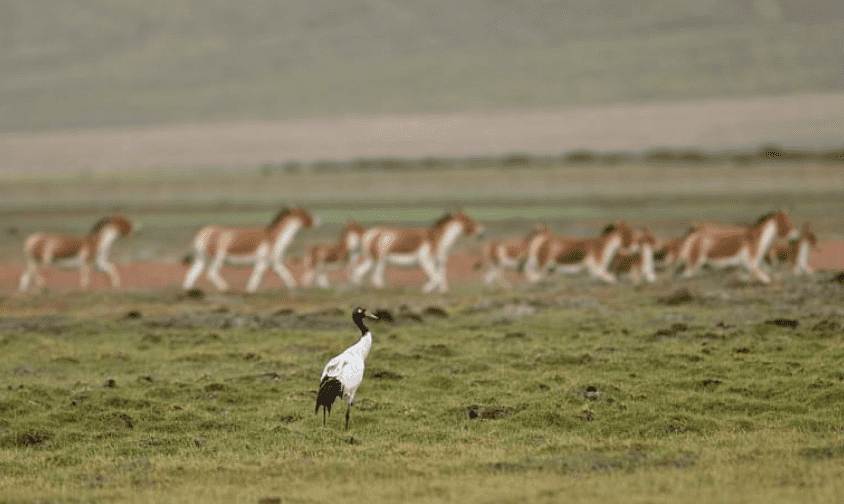
Among the 15 different crane species living on our planet and distributed across the five continents, the Black-Necked Crane is the only alpine member of the crane species. Among the major birds of Ladakh, this has a distinctive appearance. They are both unique and majestic, sporting a bright red crown, a black neck, piercing yellow eyes and up to an eight-foot wingspan. Standing tall with a height of about 4-5 feet, it is one of the largest crane species. Its striking black and white plumage, accentuated by a splash of gorgeous red on its crown, sets it apart from its counterparts.
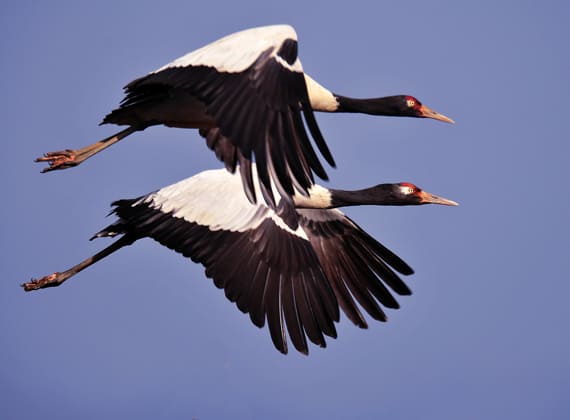
These avian marvels are only found in a few pockets in India, China, Mongolia and Bhutan. They breed in high altitude wetlands in the Tibetan plateau at elevations of 2900-4900 m above mean sea level. The high altitude marshes and lakes of the Tibetan plateau that extends to Eastern Ladakh are important breeding grounds. Adapted to the harsh conditions of high-altitude habitats, they are found in wetlands, marshes, and agricultural fields across Ladakh.
The Black-Necked Cranes sustain themselves on a diverse diet including plant roots, tubers, earthworms, grasshoppers, snails, shrimp, small fish, frogs, lizards, beetles, flies, small rodents, and other small vertebrates and invertebrates.They seek refuge in marshes during breeding with shallow water to protect their nests from predators. Despite the frigid temperatures and sparse vegetation, they thrive in these challenging environments, demonstrating their remarkable resilience. In fact, they were the last species of crane discovered and described by ornithologists due to the isolation and remoteness of their habitat range. It is said that the Russian geographer Nikolay Przhevalsky, who was a renowned explorer of Central and East Asia, first discovered Black-necked Cranes in 1876 in the Tibetan Plateau.
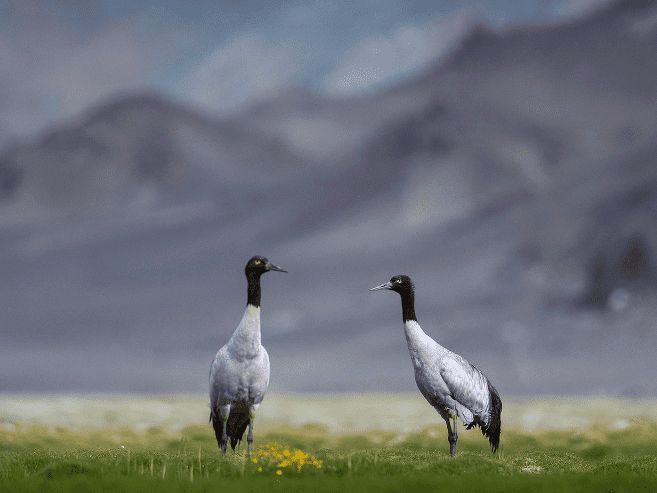
During winter, they migrate to lower-altitude river valleys, particularly favoring areas near cultivated fields. Black-necked cranes make a yearly journey between where they breed and where they spend the winter, staying for about six months in each place. Their migratory behavior enhances the feeling of wonder they create. Covering distances of over 1,500 kilometers, their migration is a testament to their resilience and adaptability. The cranes arrive in Changthang areas of Ladakh during March-April and settle around the region’s high-altitude lakes and wetlands, including Pangong Lake, Tso Kar, Chushul, Tso Moriri and Hanle. Their wintering range includes parts of southern China, Arunachal and Bhutan, where they descend from higher elevations. In the colder winter time starting from October, they fly to Bhutan (Phobjikha valley and Khotokha valley), Sikkim and parts of Arunachal Pradesh. They have also been spotted in Assam in recent years.
The Black-Necked Cranes, emblematic of the Tibetan Plateau, hold profound spiritual and cultural significance. Local communities celebrate their arrival with festivals and rituals, reinforcing the deep-rooted connection between the people and the birds. Wherever they are found in the Himalayas, they hold a revered status and are celebrated in each of these cultures. A symbol of peace, they have long been held in high regard by Asian cultures. Tibetan Buddhism considers the black-necked crane an embodiment of the Sixth Dalai Lama. Legend also has it that the previous incarnations of the Dalai Lama were carried from monastery to monastery on the backs of these holy birds.
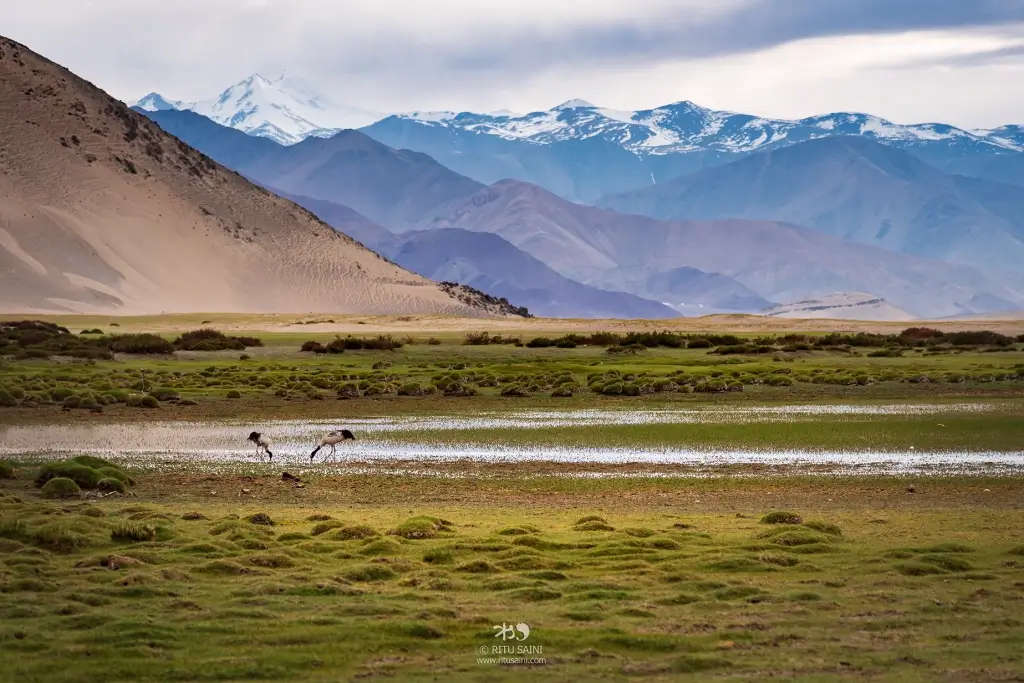
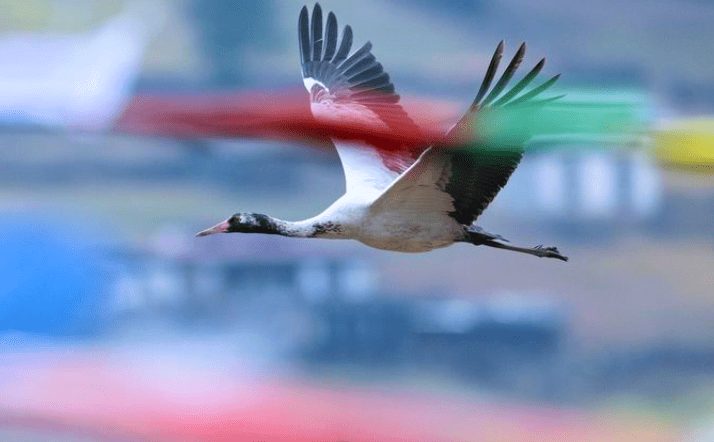
In Ladakh, the crane is a significant sacred and auspicious symbol for the locals. For centuries, local communities have understood and protected this delicate balance by celebrating these birds in their traditions and creating social taboos against harming them. The Ladakhis, especially those residing in the Changthang region, view them as both culturally significant and spiritually meaningful. The birds can be found in Ladakhi folklore and art, such as the thangka paintings in the monasteries. Many Buddhist monasteries feature paintings of the cranes alongside other sacred depictions, highlighting its revered status in their beliefs. The bird is considered to be auspicious in Ladakh and it is said that sighting them in their natural habitat brings good luck.
One of the most interesting aspects of how the Ladakhi culture is influenced by this species is the beautiful courtship display or mating ritual of these birds. Before the breeding season, the Black-Necked Cranes engage in captivating courtship displays that include singing and dancing. One of Ladakh’s most popular folk dances, the Chartses, is based on their mating dance. The Chartses dance inspired from their mating ritual has become an important feature of festivals in Ladakh and an integral part of Ladakhi folklore and tradition.
In Bhutan, the sacred birds are considered celebrities when they arrive. Near the Gangteng Buddhist Monastery, a Black-Necked Crane festival is held every year to welcome their arrival. Legend holds that upon arriving at the monastery, birds circle it three times, akin to the Buddhist ritual of circumambulation at sacred sites. This behavior symbolizes a connection between nature and spirituality, emphasizing harmony and reverence for the divine. They are the subject of Bhutanese folktales and songs, and their images can be found on the walls of temples across the country.
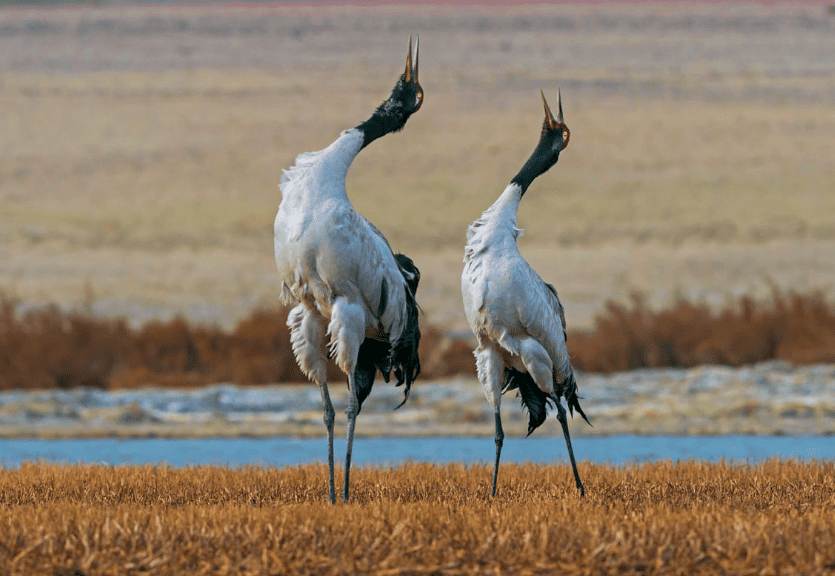
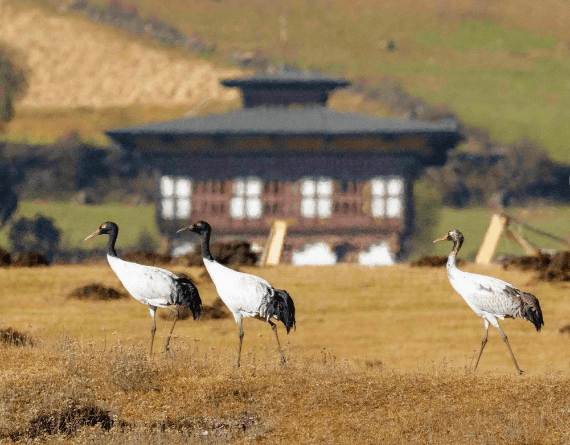
While the Black-necked Crane is a source of pride for Ladakh, it also faces numerous threats to its survival. Habitat loss, poaching, and human disturbances pose significant challenges to their population. Recognizing the importance of conservation, various initiatives have been undertaken to safeguard these iconic birds. These birds are legally protected in China, India and Bhutan.
In India, The Black-necked Crane (Grus nigricollis) is afforded the highest level of protection under the Wild Life (Protection) Act, 1972, as it is included in Schedule I. Additionally, it has most recently been assessed for The IUCN Red List of Threatened Species in 2020. Grus nigricollis is listed as ‘Near Threatened’. It is also listed in Appendix I of both the Convention on International Trade in Endangered Species of Wild Fauna and Flora (CITES) and the Convention on the Conservation of Migratory Species(CMS / Bonn Convention). Notable habitats of the Black-necked Crane, such as the Changthang Sanctuary in Ladakh, have been designated as Protected Areas. Furthermore, the Tso Kar Wetlands Complex, which serves as a vital foraging and breeding area for these cranes, was declared a Ramsar Site in December 2020, underscoring the necessity of conservation endeavors for this species.

The status as the State symbol for the avifauna, will help financially strengthen efforts to protect these unique species and conserve their natural habitats. They are indicators of a healthy functional ecosystem which the locals must protect for their own survival also. The birds therefore stands as a beacon of hope and resilience in the Ladakh Himalayas. For the people living in these secluded trans-Himalayan areas, preserving nature goes beyond mere volunteer work or acts of charity; it is deeply ingrained in their cultural identity. As the State Bird of Ladakh, it serves as a reminder of the region’s natural beauty, cultural heritage, and the importance of biodiversity conservation. Let us pledge to protect and preserve these majestic birds, ensuring that they continue to grace the skies for generations to come.
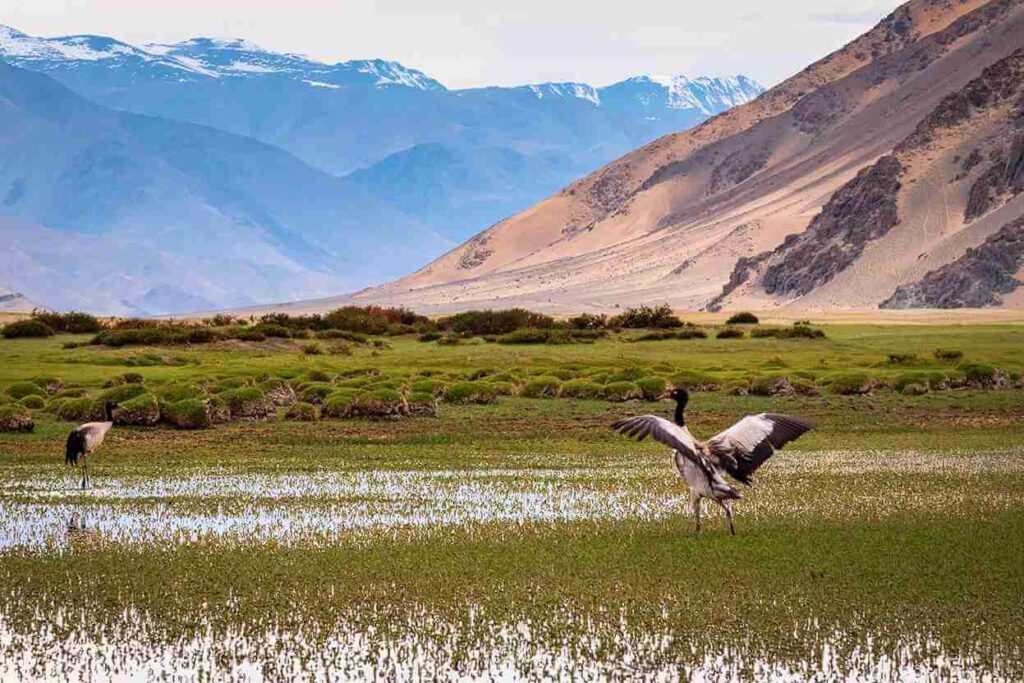
For a chance to witness these rare beautiful birds in the wild and for more information on curating your Ladakh experiences, please check out our Ladakh Trips page or connect with us here.

Contributed by our team of experiential travel experts, explorers and storytellers.

Black-Necked Crane – The state bird of ladakh that brings you good luck Black-Necked Crane – rare alpine bird of Ladakh is also a cultural icon in the Trans-Himalayas

The Best hotels in Gangtok Sikkim – unveiling the top Luxury escapes A Guide to the Finest Luxury Hotels in Gangtok, Sikkim – all offering grand views of Mt. Kanchenjunga

The Dev Kyara Trek in Uttarakhand: Best Offbeat Trek in Garhwal A GUIDE TO ONE OF THE LEAST EXPLORED REGIONS OF UTTARAKHAND Trekking in Uttarakhand is a blissful experience

The Hemis Festival: Ladakh’s Grand Cultural Carnival Ladakh is an enchantingly beautiful land steeped in ancient history, mythology and mysticisim. Here, ancient traditions come alive amidst the most rugged yet
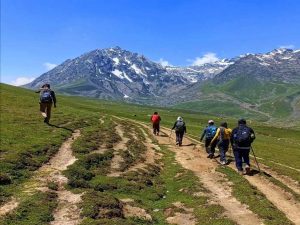
Trekking in the Himalayas: Culture, Spirituality & Adventure Himalayas, the world’s most majestic and mystical mountain range, have long beckoned adventurers, nature lovers, and spiritual seekers from all over the

Famous things to buy in Kashmir – Best Local Shopping Ideas SHARE THIS STORY Share on whatsapp WhatsApp Share on facebook Facebook Share on twitter Twitter Share on linkedin LinkedIn